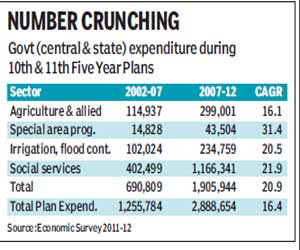With rising rural income, changing consumption patterns and higher government spend on rural employment, Indian corporates are opening up new channels to tap emerging demand in the country’s villages. While consumer goods firms and retailers have already made well-chronicled inroads to tap rural demand, truck makers, telecom companies and fuel marketers are also finding rural engagement more and more rewarding.
 ?Rural income is expected to more than triple from $572 billion in 2009-10 to $1.8 trillion by 2020-21,? says Siddhartha Roy, economic advisor at the $100-billion Tata Group. He points out that non-agricultural income is a driver of this growth. ?The share of non-farm income has seen a reversal over the last four decades, rising from 26% in the 1970s to as high as 60% in 2007-08.? Non-farm income, he says, will further rise to 68% of total rural income by 2015-16.
?Rural income is expected to more than triple from $572 billion in 2009-10 to $1.8 trillion by 2020-21,? says Siddhartha Roy, economic advisor at the $100-billion Tata Group. He points out that non-agricultural income is a driver of this growth. ?The share of non-farm income has seen a reversal over the last four decades, rising from 26% in the 1970s to as high as 60% in 2007-08.? Non-farm income, he says, will further rise to 68% of total rural income by 2015-16.
The salt-to-software Tata Group is wasting no time in tapping the new opportunities. For instance, Tata Motors, India’s largest maker of trucks and buses, launched its rural initiative Project NEEV in 2010, focusing on rural areas with a population of less than 50,000. NEEV’s network expansion approach comprised increasing the ?feet on the street? through Tata Gramin Mitras, third-party outlets called Tata Kisan Mitra and an informal network of key local influencers.
?The advantages of this method was that it required lower investment and less lead time to activate the network, and the outlets had a much deeper reach than the traditional outlets,? says Sandeep Kumar, head, sales and marketing, light and small commercial vehicles, at Tata Motors.
Driving rural consumption are some government job guarantee schemes, where more money is being progressively allocated.
Government expenditure on rural development, including schemes like the Mahatma Gandhi National Rural Employment Guarantee Scheme and the National Rural Livelihood Mission grew at a compound annual growth rate of 16%, from R1.15 lakh crore in 2002-07 to R2.99 lakh crore in 2007-12.
Meanwhile, Mahindra Navistar Automotives, a 51:49 JV between Mahindra & Mahindra and Navistar of the US, is engaging with rural markets to build its brand.
One such programme is listening to drivers and also training them to extend their working life. ?Truck drivers haven’t had their problems heard for a long time,? says Nalin Mehta, MD, Mahindra Navistar, which aims to sell 13,000 trucks this financial year. ?By listening to them we have fine-tuned our products to suit their needs and they are extremely happy.?
The company has also tweaked its service centres by engaging in a detailed study of dhabas or highway eateries, which is the lifeline of drivers.
By learning their preferences, Mahindra Navistar now offers lodging, shower facilities and canteens at their service centres. Drivers can use these facilities even if they aren?t there for a scheduled service.
German competitor Bharat Benz, a 100% subsidiary of Daimler, also made it a point to connect with the grassroots. The company had intense test sessions with truck drivers to calibrate their products before the official launch in September.
In the case of Tata Motors, the company had to arrange for finance in some cases, and tied up with more than 35 public sector banks and cooperatives. The company has also tied up with oil marketer Indian Oil Corporation (IOC), consumer goods firm ITC and Nehru Yuva Kendra Sangathan, a network of grassroots youth organisations, during the pilot phase to broaden the reach.
IOC has Kisan Seva Kendras (rural outlets), which are allowed to generate non-fuel revenue through strategic partnerships. They have 3,500 such outlets spread across the country. Peer Bharat Petroleum Corporation distributes cooking gas to rural and remote areas through its ?rural marketing vehicle?, which moves from village to village and fills cylinders on the spot.
The results have started to show. ?Rural channels contributed 15% to state volumes and 20% to districts,? says Tata Motors? Kumar.
In October, six states where the project was conducted saw 8% of total small commercial vehicle sales coming from rural areas.
?A key contributor to India?s strength has been the significant growth in consumption from its rural market,? Ernst & Young said in a study on the rural market. ?Estimates put the Indian rural market close to 45% of the total Indian GDP.?
Tata Chemicals, India?s largest salt maker, has established a rural retail model called Tata Kisan Sansar to sell farm products that contribute 52% to its revenues. With this, it aims to create direct contact with farmers, enable rural entrepreneurship and emerge as a trusted source for products and information. To reach out to the rural areas, the company today engages with 1,300 dealers (non-exclusive) and 740 Tata Kisan Sansars. With this, the company is able to cover 1.8 lakh villages, says Mona Rai, head of marketing at Tata Chemicals.
In telecom, rural users now comprise 36% of the subscription base, with mobile phones the fastest growing access point for the internet. Mobile internet users in rural India grew sevenfold between 2010 (5 lakh) and 2012 (36 lakh). To tap the opportunity, Tata Teleservices partnered with Hindustan Unilever’s Shakti entrepreneurs to make inroads into the rural ecosystem, says Sandeep Singal, head, branded retail & strategic distribution, Tata Teleservices.
















